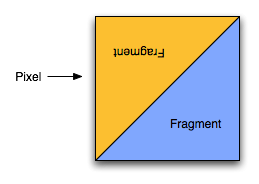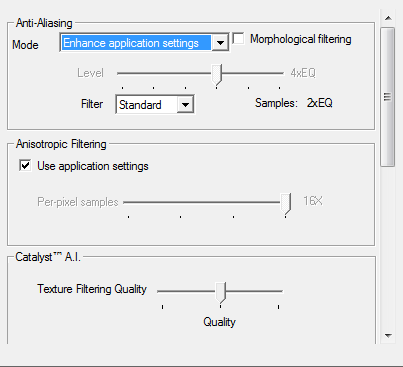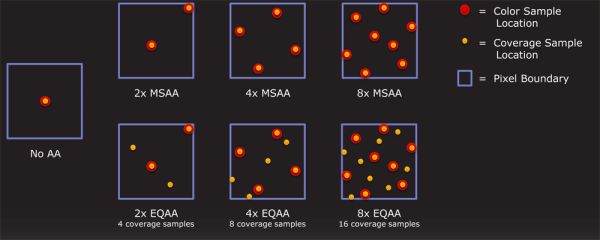AMD's Radeon HD 6970 & Radeon HD 6950: Paving The Future For AMD
by Ryan Smith on December 15, 2010 12:01 AM ESTAnother New Anti-Aliasing Mode: Enhanced Quality AA
With the 6800 series AMD introduced Morphological Anti-Aliasing (MLAA), a low-complexity post-processing anti-aliasing filter. As a post-processing filter it worked with a wide variety of games and APIs, and in most cases the performance overhead was not very severe. However it’s not the only new anti-aliasing mode that AMD has been working on.
New with the 6900 series is a mode AMD is calling Enhanced Quality Anti-Aliasing. If you recall NVIDIA’s Coverage Sample Anti-Aliasing (CSAA) introduced with the GeForce 8800GTX, then all of this should sound quite familiar – in fact it’s basically the same thing.
Under traditional MSAA, for a pixel covered by 2 or more triangles/fragments, 2, 4, or 8 subpixel samples are taken to determine what the final pixel should be. In the process the color of the triangle and the Z/depth of the triangle are both sampled and stored, and at the end of the process the results are blended together to determine the final pixel value. This process works well for resolving aliasing along polygon edges at a fraction of the cost of true super sampling, but it’s still expensive. Collecting and storing the Z and color values requires extra memory to store the values and extra memory bandwidth to work with the values. Ultimately while we need enough samples to determine colors of the involved triangles, we do not always need a great deal of them. With a few color/Z samples we have all of the color data we need in most cases, however the “hard” part of anti-aliasing becomes what the proper blending of color values should be.

1 Pixel Covred by 2 Triangles/Fragments
Thus we have EQAA, a compromise on the idea. Color/Z samples are expensive, but just checking if a triangle covers part of a subpixel is very cheap. If we have enough color/Z samples to get the necessary color information, then just doing additional simple subpixel coverage checks would allow us better determine what percentage of a pixel is covered by a given polygon, which we can then use to blend colors in a more accurate fashion. For example with 4x MSAA we can only determine if a pixel is 0/25/50/75/100 percent covered by a triangle, but with 4x EQAA where we take 4 color samples and then 4 additional coverage-only samples, we can determine blending values down to 0/12/25/37/50/62/75/87/100 percent coverage, the same amount of accuracy as using 8x MSAA. Thus in the right situation we can have quality similar to 8x MSAA for only a little over 4x MSAA’s cost.
In reality of course this doesn’t always work out as well. The best case scenario is that the additional coverage samples are almost as good as having additional color/Z samples, while the worst case scenario is that additional coverage samples are practically worthless. This depends on a game-by-game, if not pixel-by-pixel basis. In practice additional coverage samples are a way to slightly improve MSAA quality for a very, very low cost.
While NVIDIA has had the ability to take separate coverage samples since G80, AMD has not had this ability until now. With the 6900 hardware their ROPs finally gain this ability.
Beyond that, AMD and NVIDIA’s implementations are nearly identical except for the naming convention. Both can take a number of coverage samples independent of the color/Z samples based on the setting used; the only notable difference we’re aware of is that like AMD’s other AA modes, their EQAA mode can be programmed to use a custom sample pattern.
As is the case with NVIDIA’s CSAA, AMD’s EQAA mode is available to DirectX applications or can be forced through the drivers. DirectX applications can set it through the Multisample Quality attribute, which is usually abstracted to list the vendor’s name for the mode in a game’s UI. Otherwise it can be forced via the Catalyst Control Center, either by forcing an AA mode, or as is the case with NVIDIA, enhancing the AA mode by letting the game set the AA mode while the driver overrides the game and specifies different Multisample Quality attribute. Thus the “enhance application settings” AA mode is new to AMD with the 6900 series.

To be honest we’re a bit ruffled by the naming choice. True, NVIDIA did go and have to pick daft names for their CSAA modes (when is 8x not 8 sample MSAA?), but ultimately CSAA and EQAA are virtually identical. NVIDIA has a 4 year lead on AMD here, and we’d just as well use NVIDIA’s naming conventions for consistency. Instead we have the following.
| Coverage Sampling Modes: CSAA vs EQAA | ||||
| NVIDIA |
Mode (Color + Coverage) |
AMD | ||
| 2x | 2+0 | 2x | ||
| N/A | 2+2 | 2xEQ | ||
| 4x | 4+0 | 4x | ||
| 8x | 4+4 | 4xEQ | ||
| 16x | 4+12 | N/A | ||
| 8xQ | 8+0 | 8x | ||
| 16xQ | 8+8 | 8xEQ | ||
| 32x | 8+24 | N/A | ||
AMD ends up having 1 mode NVIDIA doesn’t, 2xEQ, which is 2x MSAA + 2x cover samples; meanwhile NVIDIA has 16x (4x MSAA + 12 cover samples) and 32x (8x MSAA + 24 cover samples). Finally, as we’ll see, just as is the case for NVIDIA additional coverage samples are equally cheap for AMD.











168 Comments
View All Comments
anactoraaron - Wednesday, December 15, 2010 - link
I would like to thank Ryan for the article that makes me forget the "OC card in the review" debacle. Fantastic in depth review with no real slant to team green or red. Critics go elsewhere please.Hrel - Wednesday, December 15, 2010 - link
When are you guys gonna put all these cards in bench? Some of them have been out for a relatively long time now and they're still not in bench. Please put them in there.ajlueke - Wednesday, December 15, 2010 - link
I agree with most of the conclusions I have read here. If you already own a 5800 series card, there isn't really enough here to warrant an upgrade. Some improved features and slightly improved FPS in games doesn't quite give the same upgrade incentive as the 5870 did compared a 4870.There are some cool things with the 6900 and 6800 series. Looking at the performance in games, the 6970 and even the 6870 seemed to get much closer to 2X performance when placed in crossfire as compared to 5800 series cards. That is a pretty interesting development. All in all, a good upgrade if you didn't buy a card last generation. If you did, it seems the wait is on for the 28 nm version of the GPU.
Belard - Wednesday, December 15, 2010 - link
NO!The 800 cards were the HIGH end models since the 3000 series and worked well through to the 5000 series with the 5970 being the "odd one" since the "X2" made more sense like the 4850X2.
It also allows for a "x900" series if needed.
AMD needs to NOT COPY Nvidia's naming games... did they hire someone from Nvidia? Even the GeForce 580/570 still belong to the 400 series since its the same tech. SHould have been named 490 and the 475... But hey, in 12 months, Nvidia will be up to the 700 series. Hey, Google Chrome is version 8.0 and its been on the market for about 2 years! WTF?!
What was their excuse again? Oh, to not create confusion with the 5700 series? So they frack up the whole model names for a mid-range card? The 6800's should have been 6700s, simple as that. Yes, there will be some people who will accidentally downgrade.
What the new 6000 series has going for AMD is that they are somewhat cheaper and easily cost less to make than the 5000s and what Nvidia makes.
In the end, the 6000 series is the first dumb-thing AMD has done since the 2000 series, but nowhere near as bad.
MS - Wednesday, December 15, 2010 - link
In terms of effienct usage of space though AMD is doing quite well; ... should be efficientNice article so far,
Regards,
Michael
nitrousoxide - Wednesday, December 15, 2010 - link
The power connector on the left (8-pin of 6970 and 6-pin of 6950) has a corner (bottom left corner) cut down, that's because the cooler doesn't fit with the PCB design, if you install it with force the power connector would get stuck. So the delay of 6900 Series could be due to this issue, AMD needs one month to 'manually polish' all power connectors of the stock-cards in order to go with the cooler. Well, just a joke, but this surely reflects how poorly AMD organizes the whole design and manufacture process :)nitrousoxide - Wednesday, December 15, 2010 - link
you can find this out here :)hiphotos. baidu. com/coreavc/pic/item/70f48d81ffe07cf26d811957. jpg
nitrousoxide - Wednesday, December 15, 2010 - link
AMD promises that every one will get a unique 6970 or 6950, different from any other card on the planet :)GummiRaccoon - Wednesday, December 15, 2010 - link
The performance of these cards is much better with 10.12, why didn't you test it with that?Ryan Smith - Wednesday, December 15, 2010 - link
10.12 does not support the 6900 series.8.79.6.2RC2, dated December 7th, were the absolute latest drivers for the 6900 series at the time of publication.